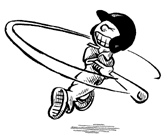
|
Physics and Acoustics of Baseball & Softball Bats
Daniel A. Russell, Ph.D. Graduate Program in Acoustics The Pennsylvania State University The contents of this page are ©2003-2011 Daniel A. Russell | 
|

|
Physics and Acoustics of Baseball & Softball Bats
Daniel A. Russell, Ph.D. Graduate Program in Acoustics The Pennsylvania State University The contents of this page are ©2003-2011 Daniel A. Russell | 
|
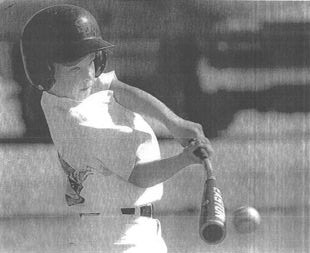 I have a received a number of questions from people who are looking to purchase a new baseball or softball bat, and while checking out various manufacturers and models, become confused by contradicting claims regarding handle flex and "whip action." Some marketing materials say that handle flex improves performance because the "whip action" allows the bat to uncoil and release energy stored during the swing and increases the bat speed at the moment of impact. Other marketing materials say that rigid bats hit balls faster because a flexible handle messes up your swing, and if not timed exactly right, can actually reduce batted ball speed. What is the truth about flexible handles? How much do bats really flex during the swing? Do bats with flexible handles outperform bats with stiff handles?
I have a received a number of questions from people who are looking to purchase a new baseball or softball bat, and while checking out various manufacturers and models, become confused by contradicting claims regarding handle flex and "whip action." Some marketing materials say that handle flex improves performance because the "whip action" allows the bat to uncoil and release energy stored during the swing and increases the bat speed at the moment of impact. Other marketing materials say that rigid bats hit balls faster because a flexible handle messes up your swing, and if not timed exactly right, can actually reduce batted ball speed. What is the truth about flexible handles? How much do bats really flex during the swing? Do bats with flexible handles outperform bats with stiff handles?
This is a tough question, made more difficult by the fact that some of the biggest bat manufacturers in the business have gone in exactly the opposite direction on this issue. On the flexible handle side DeMarini has their whole family of half-half bats with flexible composite handles for slow-pitch softball (Dark, EVO, White-Steel, F2) as well as several youth baseball bats (Voodoo, Hooligan, Vexxum, F2) and women's fast-pitch softball (Medusa, EVO). Easton has been using their ConneXion joint for a while, but have recently begun using it to join a flexible composite handle to aluminum and composite barrels. Their Stealth and Stealth CNT line of bats available for slow-pitch softball, youth baseball and adult baseball are all available in stiff, regular, and flexible flavors. Marketing information about flexible handled bats state that handle flex allows energy stored in the whip action during the swing is released at impact to provide a greater batted-ball speed. On the stiff side, Louisville Slugger has the Exogrid, Dynasty, Omaha and Catalyst for softball and baseball. These Louisville Slugger bats, also with composite handles, are much stiffer than the typical aluminum bat. Marketing materials for stiff handled bats claim that stiffer handles allow the trampoline effect in the barrel to be more effective thus improving batted-ball speed.
Here are some specific questions that I will try to answer - based on what I know about bats, and based on the published research literature that is available.
Before we move on and tackle these questions, there is one thing I must say first. The photo at the top of this page appears to show a bat flexing prior to impact, suggesting that the so-called "whip action" is real and that the elastic properties of the bat are causing the bat to spring forward towards the ball resulting in a faster bat speed at the moment of collision. The photo shows the bat to be flexing a rather amazing amount, and the player is not a big strong giant like Barry Bond. However, this photo does NOT show a bat flexing prior to the collision, but instead shows the bat after the collision with the ball is over, and the bat is flexing due to vibrations caused by the collision with the ball. I'll show and discuss this phenomena below in more detail.
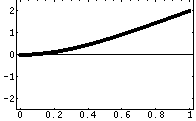 The more flexible a bat is, the easier it is to make it bend or flex. The "diving board" vibrational mode of a bat is one in which the bat is considered to be clamped at the handle and free to vibrate at the barrel end. The bat flexes and vibrates much like a diving board. If a bat undergoes a significant flexing, or whip action, during the swing then a diving board type motion should be observed. Research has shown that, in the hands of a batter, a baseball or softball bat does not behave like a clamped-free bat, but rather like a damped free-free bat.[1] Thus, it is questionable - at least for wood and aluminum bats - whether a diving board mode providing "whip action" is present during the bat swing. Before I attempt to tackle that specific question directly, let me first take a look at golf shafts and golf swing - where flexible shafts and diving board modes are present and can significantly affect performance.
The more flexible a bat is, the easier it is to make it bend or flex. The "diving board" vibrational mode of a bat is one in which the bat is considered to be clamped at the handle and free to vibrate at the barrel end. The bat flexes and vibrates much like a diving board. If a bat undergoes a significant flexing, or whip action, during the swing then a diving board type motion should be observed. Research has shown that, in the hands of a batter, a baseball or softball bat does not behave like a clamped-free bat, but rather like a damped free-free bat.[1] Thus, it is questionable - at least for wood and aluminum bats - whether a diving board mode providing "whip action" is present during the bat swing. Before I attempt to tackle that specific question directly, let me first take a look at golf shafts and golf swing - where flexible shafts and diving board modes are present and can significantly affect performance.
|
The image at right is a still-frame from a video of an amateur golfer swinging a wood driver. The frame clearly shows the golf shaft flexing backwards during the down swing.
The graph at far right shows a typical measurement of the strain in the shaft of a golf club during the swing as measured by attaching strain gauges to the shaft.[2] The graph shows that during the back swing and down swing the shaft oscillates between being bent backwards and forwards. This graph actually shows that the shaft is bent forwards, flexing towards the ball at the moment of impact. Similar analysis of multiple players swinging the same shaft show that while there is some variation in the direction and amount of shaft flex during the back swing and down swing, at the instant of impact the club shaft is usually bent forwards flexing towards the ball for most players.[3] Professional players will often have multiple clubs with varying amounts of stiffness depending on how they need to play the ball. Whether the shaft is bent forwards or backwards at the moment of impact affects the angle with which the club face meets the ball, and thus affects the angle of launch, and the eventual distance the ball travels.[2,3] |
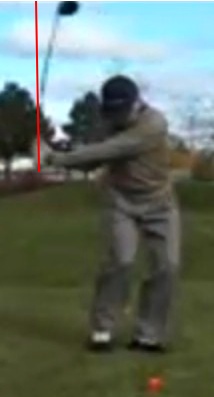 |
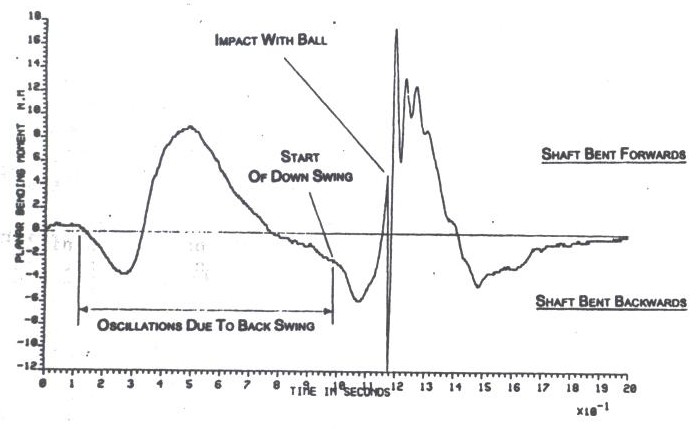 |
As a further example of shaft flex during the swing - here are several still shots from a high speed movie (4000 frames per second) of Tiger Woods swinging a wood driver. Click on the image for a larger version. The flex in the shaft is identified by the cyan curve and the yellow line indicates a straight line from the handle grip. If we analyze Tiger's swing, we find that during the back swing (a-b) the club is bent forwards, lagging the handle as it swings back. At the top of the swing (c) the club is bent backwards due to the inertia of the club head as Tiger reverses the direction of his swing. On the down swing (e) the club shaft is initially bent backwards, but becomes straight (f) and actually bends forwards (g) just before impact. At the moment of impact (h), Tiger's club is straight. What impresses me is the fact that the flex in the club during the swing is large enough that it can be observed.
|
One researcher claiming to have done just that is Dr. Larry Noble, Professor of BioMechanics of Human Movement in the Kinesiology Department at Kansas State University. Dr. Noble did some consulting work for Easton back in the early 1990's and collected data on several "hyper-flexible" aluminum bats that manufacturers claimed provided a "whip-action" during the swing. Dr. Noble attached string gauges to the taper region of several aluminum softball bats and measured the strain during the swing and impact for several male and female college student batters. The figure at right shows a typical strain curve for the best hitter in Noble's study.[6,7] The strain curve appears to show the bat flexing towards the ball at the beginning of the swing, then flexing back away from the ball and then finally flexing forwards towards the ball so that the bat is slightly bent forwards at the moment of impact. Noble claims that such results support the claim that the diving board vibration mode is excited during the swing.
A problem with this claim is that the "swing frequency" of this measured diving board mode obtained from the strain gauge response is 6.5 Hz, which is only about half of the expected value. When the same bat was clamped in a vise grip at the handle the diving board was measured to be 13.3 Hz. The free-free vibrational frequency of the bat was 156 Hz, and the hand-held bat has a slightly lower impact frequency of 139 Hz because the hands provide a mass-loading effect which lowers the frequency of the free-free vibration. But, the hands are less massive than a clamped boundary condition so the observed "swing frequency" should have been higher than 13 Hz, not lower. In the conclusion of his paper Noble says that the vibration of the bat during the swing does not appear to be caused by the diving board vibrational mode but instead "appears to be related to the torques produced by the hitter's hands during the swing." However, he claims to have found that "the magnitude of bat bending was significantly related to post-impact ball velocity for all subjects," and therefore supports manufacturer's claims that bats with flexible handles (remember that these were 1990's aluminum bats) provide a "springboard effect at impact through the release of elastic energy stored during the swing." During the Spring of 2006 we made some similar measurements of handle flex during swing for aluminum bat in the acoustics laboratory here at Kettering University. We weren't specifically trying to measure handle flex - we were trying to measure the amount of sting in the top hand. We attached strain gauges to the handle at the knob and at position of top hand (about 7-inches from the knob). The bat was swung to hit a softball off a tee, so that the strain gauges were horizontal to the plane of the swing at the moment of impact. The figure at right shows the strain-time curve that we measured on the handle of a DeMarini B52 slow-pitch softball bat. The figure represents the average of 5 good impacts at the sweetspot. The time scale for our swing is the same as for Noble's data. The vibration after impact is very similar to that measured by Noble, with the post-impact vibrating being dominated by the 143 Hz first bending mode of vibration (the free-free frequency was 145 Hz). However, the apparent flexing during the swing took much longer for our bat, with our measurement of "swing frequency" being 2.2 Hz, much lower than Noble's measurement of 6.5 Hz, which in turn is only half of what the diving board mode frequency should be. |
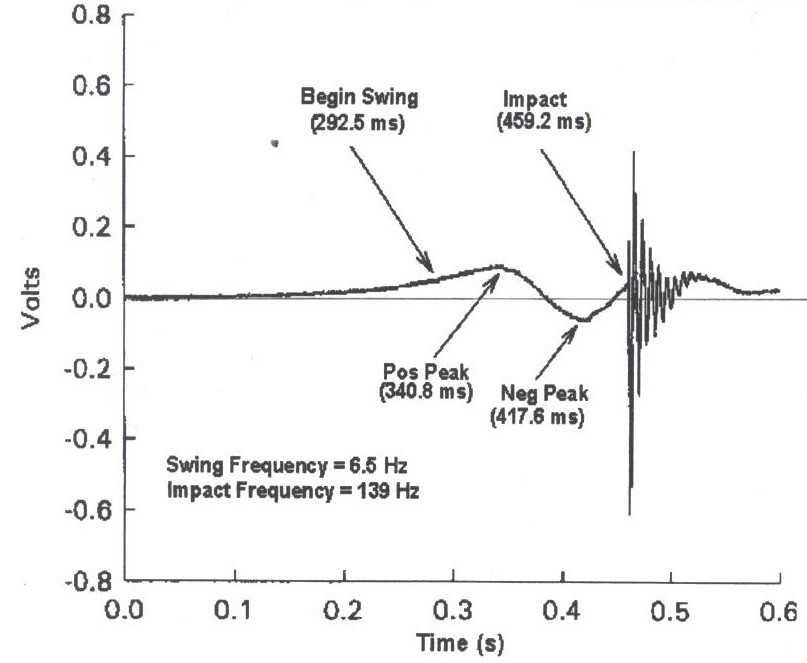
|
The only research I am aware of that attempts to quantify the effect of whip action and handle flex in terms of a measurable improvement in performance is described in a couple of papers by the research group from the Baseball Research Center at the University of Massachusetts Lowell. They approached the problem of bat performance by looking at the conservation of energy including the translation and rotational energy shared between the bat and ball before and after the collision.[4] Analysis of high speed video recordings of thousands of swings by major league baseball players showed that the potential energy stored in "whip" flexing of the bat during swing accounts for only about 0.5% of the total energy in the bat-ball system. The same research group created a Finite Element Analysis model[5] of a rotating bat meeting a moving ball and predicted that the increase in batted-ball speed gained by accounting for flex in wood and aluminum baseball bats would only be in the amount of 0.4 mph. The research study concluded that whip action did not significantly contribute to final batted-ball speed for wood and aluminum baseball bats and could effectively be ignored.
The photos below are still frames from a movie I made in my research lab to demonstrate the flexibility of some recent bat models. I took four bats with handles that the manufacturer claims are flexible (youth baseball, women's fast-pitch softball, prototype slow-pitch softball, and men's slow-pitch softball) and attempted to bend the handles by gripping the bat at the barrel and taper region and pressed the knob as hard as possible at an angle on the floor. The point was to demonstrate that some bat handles are much more flexible than others. The first three bats have extremely flexible handles which can easily be bent. The fourth bat is a popular model with a flexible composite handle. It is possible to see a very slight amount of flex in the image (more noticeable in the movie), but nowhere near the amount of flex that the other three bats exhibit. And, I should note that I tried this with several aluminum bats and could see absolutely no evidence of the slightest amount of flex - at not least anything that the human eye can detect. So, I have a very hard time believing that an aluminum bat would exhibit any flex during the swing - at least not to the extent that it would actually contribute to an improvement in the batted-ball speed. I would be willing to change my mind if I saw concrete evidence to the contrary, but based on what I currently know about handle stiffness, different bat materials, and what I have analyzed from high speed film footage of players swinging softball and baseball bats, I have difficulty believing that aluminum bats would flex during the swing, nor that "flexible" composite bats flex enough during the swing to affect performance.
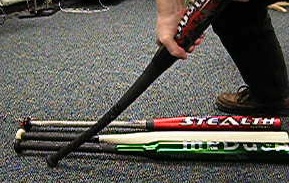
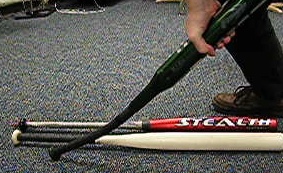
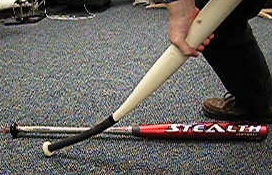
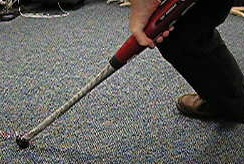
|
| Three-point flexural stiffness test. One way is to measure the amount of force required to bend (or flex) the bat a specific distance using a three-point test fixture. The bat is placed in the fixture so that the bat is supported from below at two points: the handle and barrel. A force is applied at a third point above the bat, near the taper region 12-inches from the knob. A 5-lb pre-load is applied to the middle point and the load and deflection displays are zeroed out. Then a continuous load (usually with a rate of 1 in/min) is applied pushing downwards at the middle point until the handle deflects 0.25-inches. The value of the force in pounds required to deflect the 12-inch point on the handle by 0.25-inches is recorded as the "handle stiffness" value. |  |
| Bending Frequencies A second way to estimate the relative stiffness/flexibility between two bats is to measure the frequencies of the bending modes of vibration for each bat. Usually this is done using experimental modal analysis. The bending frequencies will be lower for the more flexible bat, and higher for the stiffer bat. The graph at right compares the frequencies of the first bending mode to the frequency of the first hoop mode in the barrel for a variety of slow-pitch softball bats.[8] Most slow-pitch softball bats have a bending frequency of around 160 Hz, but there are some bats with frequencies as low as 80 Hz or as high as 250 Hz. Bending frequencies for baseball bats tend to be slightly higher in frequency - as compared to the same model softball bat - mainly because the diameter of a baseball bat is slightly larger. But, there is a similar range of bending stiffnesses available for baseball bats at both the youth and adult levels. | 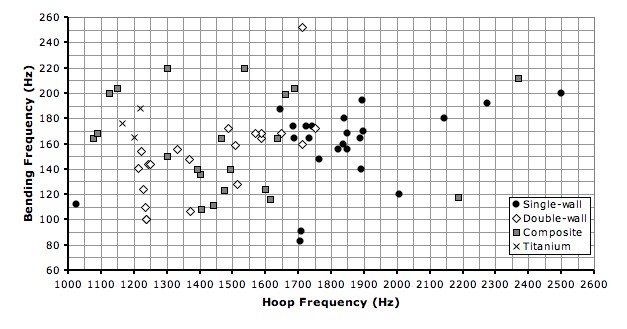 |
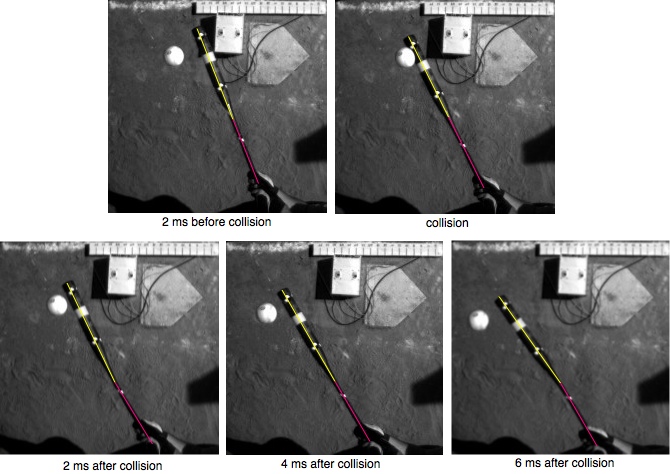
More data showing post-impact flexing of bats - this time for Baseball Bats
Here are some more examples of bat flexing after impact. The following three sequences of images were cropped from frames of high speed movies (1000 fps) of a player hitting pitched baseballs. Each pair of images corresponds to the instant of collision with the ball and 0.004 seconds after the collision. I've added some red straight lines to help showcase the flexing of the bat. The important thing about these photos is that they illustrate clearly the differences in bat flex for impacts at or away from the sweet spot.
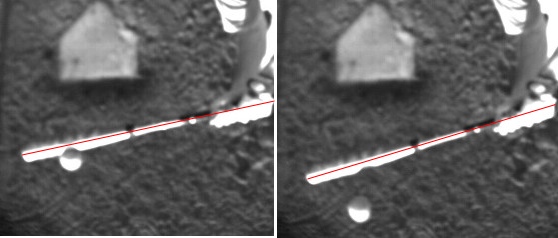
Flexible Bat - Impact AT Sweet Spot |
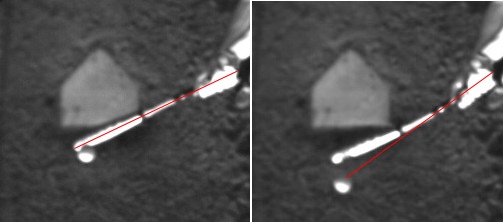
Flexible Bat - Impact OUTSIDE Sweet Spot |
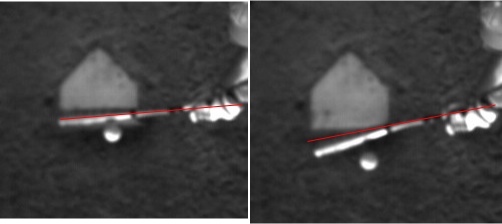
Flexible Bat - Impact INSIDE Sweet Spot |
Physicist Alan Nathan published an important paper[10] in which he investigates the bat-ball interaction (for a wood bat) and addresses the issue of bat flexibility by looking at how important the vibrational behavior of the bat is to the final exit speed of the ball.
| 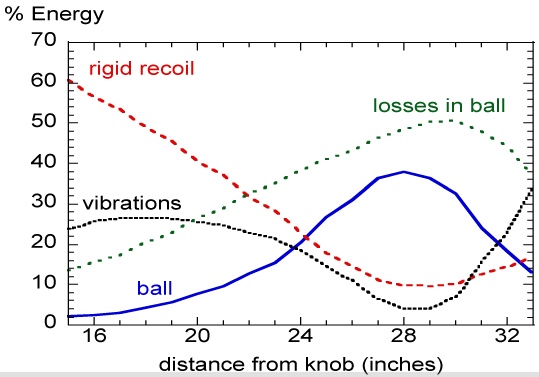
|
|
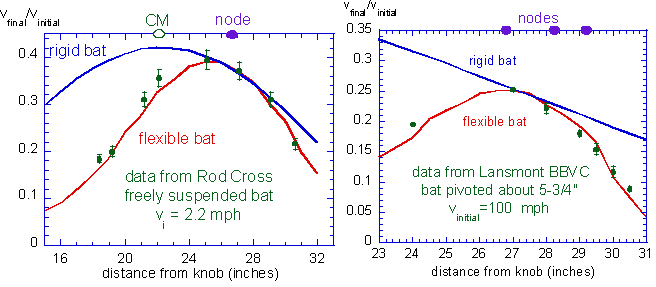 |
|
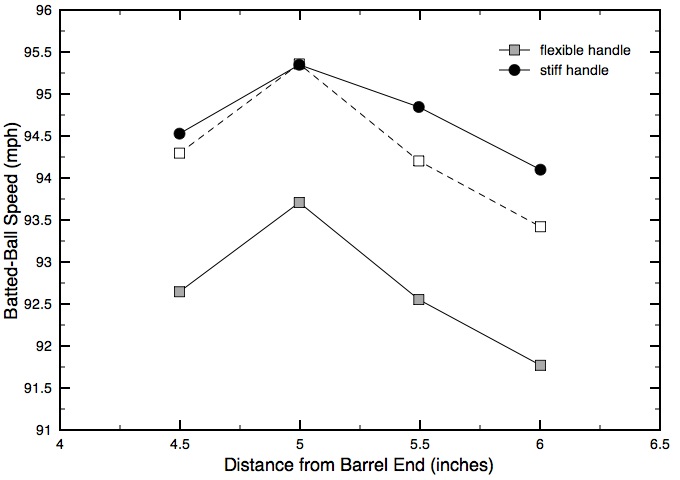
|
The trends in Becky's data are very interesting in that they agree with the experimental results of Naruo and Sato, and with Alan Nathan's theoretical predictions. However, I wouldn't rush out and purchase a stiffer bat based on this data just yet. It only represents two bats, and the bats were different in several other ways, not just in the amount of handle flex. In order to improve the reliability of this result, I would want to see data for at least half a dozen bats, where the only thing different is the handle stiffness - all other properties (hoop frequency, barrel compression, moment-of-inertia, etc.) are the same.
We ran the test for three slow-pitch softball bats that appeared to be nearly identical in all of the ways that could influence batted-ball speed (moment-of-inertia, hoop frequency, barrel compression) but which have very different handle stiffnesses - as evidenced in the frequency of the first bending mode of vibration. We impacted each location on the bat barrel twice (we should have done six impacts at each location, but had problems with the cannon and ran out of time), and the ball speeds shown are the average of the two impacts. It should also be pointed out that the high-speed cannon test has an error of ±2 mph, so that a result of 94 mph really means 92-96 mph.
The data appears to show that the flexible handle bat had about 1-mph better performance than the stiff bat, which contradicts the experimental results of just discussed above. However, we need more than two impacts at each location to provide statistical confidence in the results. With the built-in uncertainty in the test, this result does not suggest a significant difference between a flexible, medium and stiff handled softball bat, either in terms of the batted-ball speed or the effective width of the sweet spot.
|
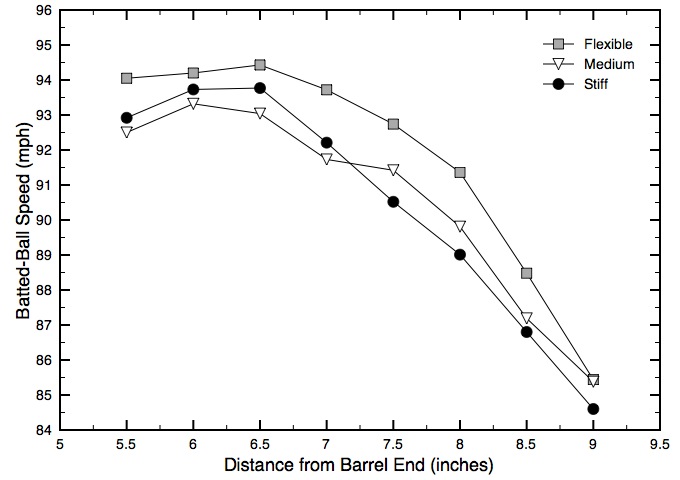
|
|
For impacts at the sweet spot, there should be no noticeable difference in the sensation of vibration in the batter's hands because impacts at the nodes minimize the bat's vibration. However, for impacts away from the sweet spot, there might be significant differences in feel between stiff and flexible bats. The difference in feel between the stiff and flexible bats would be due to differences in the frequencies of the bending vibration after impact.
An important study in the late 1970's concerning the human response to vibration in the hands while holding a vibrating object showed that the sensation of discomfort in the hands is strongly dependent on frequency.[14] The curves in the graph at right are taken from this study, and show the threshold level (above which vibration is readily detected) and the annoyance level (above which the vibration sensation becomes painful) as function of frequency. The curves show that human hands tend to be most sensitive to frequencies in the range of 160-400 Hz (gray shaded region) with sensation rapidly decreasing for higher or lower frequencies. Larry Noble conducted a similar study[15] in which several men and women tightly gripped a rod vibrating at various frequencies and rated the annoyance of the sensation. Noble found that frequencies above 250 Hz were perceived as being much less annoying than lower frequencies, and that frequencies in the range 100-125 Hz were considered the most annoying.
Robert Adair uses the frequency dependence of hand sensation to argue for the node of the first bending vibration mode as representing the location of the sweet spot of a bat.[16]
Based on laboratory data I have seen, I am beginning to believe that it is the second bending mode which is more important to the sensation of sting - at least as it affects the painful stinging in the top hand for a poorly hit ball.[17] So, which feels better, a stiff or flexible handle? Well, we have to go back to the curve at right. The data points and dashed lines correspond to two slow-pitch softball bats in my laboratory. The red data points are for a flexible bat, and the blue data points are for a stiff bat. For the flexible bat, the frequency of the first bending mode is much lower than the sensitive range, but the frequency of the second bending mode is very close to the most sensitive range of frequencies. For the stiff bat, the frequency of the first bending mode is right in the middle of the most sensitive frequency range, while the second bending mode is at a much higher frequency. If the frequency of the first bending mode has the greatest influence on the perception of sting, then a flexible bat should feel better for impacts away from the sweet spot. However, if it is the second bending mode that most influences the perception of sting, then the stiff bat would cause less pain in the hands of the batter. |
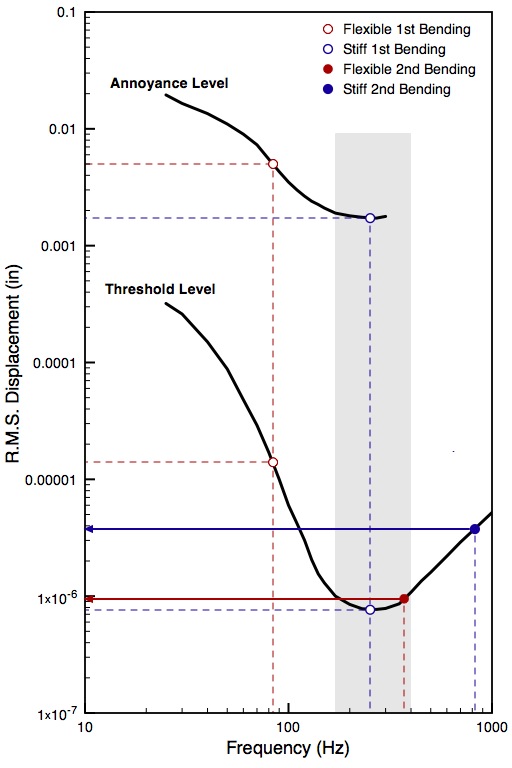
|
This topi is currently under investigation in our laboratory. I have a group of students who are trying to measure the vibration in the handle during and after impact by attaching strain gauges to the handle at the locations of the top and bottom hands. They will be hitting balls off tees (they're engineers not ball players) and we'll be using high speed video overhead to look at bat motion/ vibration before, during, and after the swing, as well as looking at the output from the strain gauges. They will be comparing several softball bats with extremes of handle stiffness. I don't know what to expect, but I hope to see how the vibration in the handle compares for stiff vs flexible bats, and to see if we can detect any flexing in the handle during the swing.
Back to Physics and Acoustics of Baseball & Softball Bats